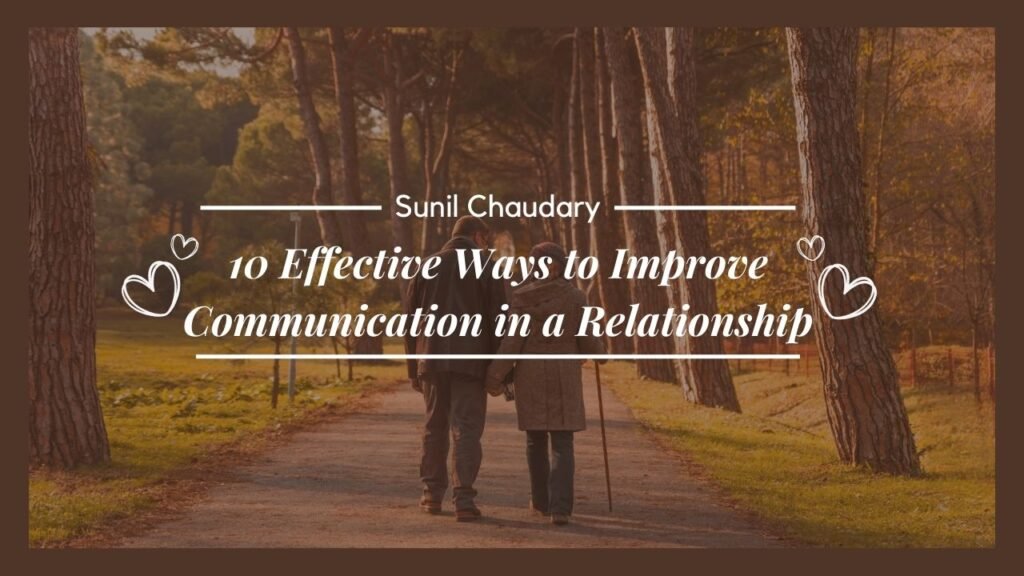10 Ways to Improve Communication in a Relationship: A Detailed GuideEffective communication is the cornerstone of a healthy relationship. It fosters understanding, builds trust, and helps partners navigate challenges together. Whether you’re in a new relationship or have been together for years, improving communication can strengthen your bond. Here are ten actionable strategies to enhance communication in your relationship.
1. Practice Active Listening
Active listening involves fully concentrating on what your partner is saying rather than just passively hearing their words. This shows that you value their thoughts and feelings.
A. Be Present
- Eliminate distractions by putting away your phone or turning off the TV during conversations.
- Maintain eye contact to show engagement and attentiveness.
B. Reflect and Respond
- Summarize or paraphrase what your partner has said to ensure you understand their message correctly.
- Ask follow-up questions to show interest and clarify any uncertainties.
2. Express Your Feelings Openly
Being open about your feelings helps create a safe space for both partners to express themselves without fear of judgment.
A. Use “I” Statements
- Frame your feelings in terms of “I” rather than “you” to avoid sounding accusatory. For example, say “I feel neglected when…” instead of “You never listen…”.
B. Be Honest and Vulnerable
- Share your thoughts and emotions honestly, even if they are difficult. Vulnerability fosters intimacy and understanding.
3. Establish a Safe Space for Conversations
Creating a supportive environment encourages open dialogue and minimizes defensiveness.
A. Choose the Right Time and Place
- Avoid discussing important issues during stressful times or in public settings. Instead, choose a calm environment where both partners feel comfortable.
B. Set Ground Rules
- Agree on rules for discussions, such as no interruptions and respecting each other’s viewpoints, to ensure a respectful exchange.
4. Practice Empathy
Empathy involves understanding your partner’s feelings and perspectives, even if you don’t necessarily agree with them.
A. Acknowledge Their Feelings
- Validate your partner’s emotions by acknowledging their feelings, even if you see things differently. Phrases like “I understand why you feel that way” can be reassuring.
B. Put Yourself in Their Shoes
- Try to view situations from your partner’s perspective. This can help reduce conflict and enhance connection.
5. Communicate Regularly
Regular communication helps maintain connection and keeps both partners on the same page regarding their feelings and experiences.
A. Check-Ins
- Schedule regular check-ins, whether daily or weekly, to discuss feelings, concerns, and any changes in the relationship dynamics.
B. Share Daily Experiences
- Make it a habit to share daily highlights or lowlights. This helps you stay connected and aware of each other’s lives.
6. Be Mindful of Non-Verbal Communication
Non-verbal cues, such as body language and tone of voice, play a significant role in communication.
A. Observe Body Language
- Pay attention to your partner’s body language and facial expressions. These cues can convey emotions that may not be expressed verbally.
B. Match Tone and Gesture
- Ensure that your non-verbal signals align with your verbal message. For example, using an open posture can convey approachability and sincerity.
7. Address Issues Early
Avoiding conflicts can lead to resentment and misunderstandings. Address issues as they arise to prevent them from escalating.
A. Tackle Problems Together
- Approach challenges as a team rather than adversaries. Use collaborative language such as “Let’s figure this out together.”
B. Don’t Let Anger Fester
- If something bothers you, express your feelings calmly and respectfully before it turns into a larger issue.
8. Set Aside Quality Time
Spending quality time together fosters connection and opens the door for deeper conversations.
A. Schedule Regular Date Nights
- Prioritize regular date nights or quality time, free from distractions, to nurture your relationship and encourage open dialogue.
B. Engage in Shared Activities
- Participate in activities you both enjoy, which can create opportunities for relaxed conversations.
9. Use Humor to Diffuse Tension
Humor can help lighten the mood during difficult conversations and create a more relaxed atmosphere.
A. Laughter as a Bonding Tool
- Use humor appropriately to ease tension and foster connection. Lighthearted jokes or playful teasing can help create a positive environment.
B. Avoid Sarcasm During Serious Discussions
- While humor can be beneficial, avoid sarcasm or jokes that might be misinterpreted during serious conversations.
10. Seek Professional Help if Needed
Sometimes, communication issues may stem from deeper problems in the relationship. Seeking professional help can provide valuable insights and tools for improvement.
A. Couples Therapy
- Consider couples therapy or counseling to address ongoing communication challenges with the guidance of a trained professional.
B. Workshops and Resources
- Attend workshops or read books focused on communication in relationships to gain new perspectives and techniques.
Conclusion
Improving communication in a relationship requires effort, patience, and a willingness to grow together. By practicing active listening, expressing feelings openly, and fostering empathy, you can enhance your connection and create a more supportive partnership. Remember that effective communication is an ongoing process, and being proactive in addressing challenges will lead to a stronger, healthier relationship over time. Embrace these strategies and watch your relationship flourish!
Understanding the Importance of Communication
Effective communication is a cornerstone of any healthy relationship. It plays a crucial role in fostering trust and ensuring emotional intimacy between partners. When individuals engage in open and honest dialogue, they create an environment where both parties feel valued and understood. This, in turn, strengthens the emotional bonds that form the foundation of their partnership.
Moreover, effective communication is instrumental in conflict resolution. Every relationship encounters disagreements, but how these disputes are managed can significantly influence the overall dynamics between partners. By articulating feelings and perspectives clearly, couples can navigate conflicts with greater ease and empathy. This process not only helps to address immediate issues but also equips couples with the skills to handle future disagreements more constructively.
Open communication allows partners to express their needs and desires, facilitating a deeper understanding of one another. When both individuals feel comfortable sharing their thoughts and feelings, they are better equipped to support each other through challenges. This mutual support fortifies the relationship and enhances the emotional connection that partners share.
Furthermore, effective communication extends beyond mere words. Non-verbal cues, such as body language and facial expressions, are equally important in conveying messages. Being attentive to these signals can prevent misunderstandings and misinterpretations, enabling partners to respond to each other’s emotional states more appropriately.
In conclusion, the importance of communication in a relationship cannot be overstated. It fosters trust, aids in conflict resolution, and strengthens emotional bonds. By prioritizing open and honest dialogue, partners can cultivate a more profound understanding of one another, leading to a healthier and more fulfilling relationship.
Active Listening Skills
Active listening is a fundamental component of effective communication in any relationship. It goes beyond merely hearing the words that your partner is saying; instead, it involves fully engaging with the speaker, understanding their message, and responding thoughtfully. This skill contrasts sharply with passive hearing, where one might be present but not truly absorbing the information being conveyed. By honing active listening skills, partners can deepen their connection and foster a more open line of communication.
One of the essential strategies for becoming an active listener is to maintain eye contact. This nonverbal cue demonstrates to your partner that you are genuinely paying attention and are interested in what they are saying. It creates a sense of intimacy and trust and removes distractions that may divert your focus. Additionally, being physically present—free from distractions such as phones or television—can significantly enhance your ability to listen actively.
Avoiding interruptions is another crucial aspect of active listening. Many individuals have a tendency to interrupt or finish their partner’s sentences, often with the intention of expressing agreement or offering solutions. However, this practice can hinder effective communication and make the speaker feel unvalued. Allowing your partner to express their thoughts without interjecting enables you to fully comprehend their perspectives and feelings.
Lastly, reflecting back what your partner has said is a powerful technique in active listening. Paraphrasing their concerns or feelings not only validates their emotions but also provides an opportunity for clarification. This strategy ensures both partners are on the same page and can lead to a more constructive dialogue. By employing these strategies, individuals can enhance their ability to engage in meaningful conversations, ultimately improving the overall communication in their relationship.
Using ‘I’ Statements
In interpersonal communications, especially within the dynamics of a relationship, the way one expresses thoughts and feelings can significantly influence the outcome of a discussion. One highly effective technique for fostering open dialogue is the use of ‘I’ statements. This method is centered on articulating personal feelings rather than attributing blame or judgment to the other party.
To effectively formulate ‘I’ statements, begin by expressing your feelings about a specific situation. For instance, rather than saying, “You never listen to me,” which may provoke defensiveness, try rephrasing it to, “I feel unheard when we discuss our plans.” This adjustment shifts the focus from the partner’s actions to your emotional response, which helps in minimizing defensiveness. A well-structured ‘I’ statement typically consists of three components: the emotion being felt, the behavior causing that emotion, and the desired outcome or change.
Another essential aspect of using ‘I’ statements is timing. Choosing the right moment to convey your sentiments can enhance receptiveness. Attempt to discuss sensitive issues when both parties are calm and willing to engage. This environment fosters a constructive atmosphere conducive to mutual understanding. It is also beneficial to maintain a positive tone and to listen actively to your partner’s responses. ‘I’ statements do not just enhance expression; they also promote better listening and understanding.
Incorporating this technique into daily interactions can gradually enhance communication within a relationship. Over time, partners can develop a more profound understanding of each other’s needs and emotions, contributing to a healthier and more open dialogue. By consistently practicing this approach, couples can effectively reduce conflict and build a stronger, more empathetic connection.
Non-verbal Communication Awareness
Non-verbal communication plays a crucial role in conveying messages and emotions in relationships. It encompasses a variety of forms including body language, facial expressions, gestures, and tone of voice. These elements often transmit more information than spoken words, highlighting the importance of being attentive to non-verbal cues during interactions with a partner. Understanding and interpreting these signals can significantly enhance communication and foster deeper connections.
Body language is one of the most influential non-verbal cues, as it can reveal discomfort, confidence, openness, or defensiveness. For instance, maintaining eye contact often denotes interest and attentiveness, whereas crossed arms may indicate withdrawal or resistance. Couples should strive to recognize their own body language and the messages it sends, as well as assess the body language of their partners. This reciprocal awareness can lead to more compassionate and responsive interactions.
Facial expressions constitute another powerful form of non-verbal communication. A smile can convey warmth and acceptance, while frowning might suggest confusion or disagreement. Being able to read these subtle expressions can help individuals gauge the emotional state of their partner, allowing for timely interventions or reassurances when necessary. Furthermore, tone of voice, including pitch, volume, and pace, can significantly affect how a message is perceived. A calm and measured tone can foster a sense of security, while a raised voice may escalate tension.
In summary, the significance of non-verbal communication should not be understated in romantic relationships. By becoming more aware of one’s own non-verbal signals and learning to interpret those of a partner, couples can better navigate their interactions. Enhanced understanding through effective non-verbal communication can improve not only the exchange of information but also deepen emotional intimacy in a relationship.
Setting Aside Quality Time for Conversations
Effective communication in a relationship is greatly enhanced by the practice of setting aside quality time for meaningful conversations. In our fast-paced world, distractions are prevalent, making it essential to create a dedicated space where both partners can engage in open dialogues. This environment fosters intimacy and allows for deeper understanding.
To begin with, it is important to establish a comfortable setting for these conversations. Choose a location that promotes relaxation, such as a cozy corner of your home or a favorite park. Ensure this environment is free of distractions, allowing both partners to focus entirely on the discussion at hand. Pillows, soft lighting, and a warm atmosphere can significantly enhance this experience.
Equally crucial is setting boundaries around technology. Smartphones and other electronic devices can easily disrupt the flow of conversation; therefore, it is advisable to designate specific times for communication that are free from technological interruptions. By silencing phones or placing them in another room, both partners can give their full attention to each other. This demonstrates respect and a desire to communicate effectively, reinforcing the importance of the discussion.
Prioritizing these moments to talk is essential in nurturing the relationship. Schedule regular check-ins, perhaps once a week, where both partners can share their feelings and thoughts without time constraints. By making these conversations a priority, couples can cultivate a stronger emotional connection that ultimately enhances their overall communication.
In conclusion, setting aside quality time for conversations is fundamental to fostering effective communication in a relationship. By creating a comfortable environment, establishing technology boundaries, and prioritizing discussions, couples can significantly improve their connection, resulting in a more harmonious and understanding partnership.
Being Open and Honest
Transparency in a relationship is a cornerstone that fosters trust and deepens emotional connections between partners. When individuals commit to being open and honest, they cultivate an environment where misunderstandings are minimal and intimacy flourishes. Honesty not only reduces the risk of conflict but also encourages mutual respect and reinforces the bond that partners share.
One effective strategy to enhance communication is to share personal fears and desires openly. This practice allows individuals to express their thoughts candidly, providing their partner with insight into their emotional landscape. By articulating one’s needs and vulnerabilities, couples can work together towards a better understanding of each other, leading to increased levels of empathy and support. Encourage discussions about expectations in the relationship, which can prevent assumptions and misinterpretations from taking root.
Being open also involves inviting feedback from your partner. This reciprocal dialogue is crucial as it helps both individuals explore and understand each other’s perspectives. By asking questions and genuinely listening to the answers, partners create a space where honesty thrives. It is equally important to remain patient and compassionate during these discussions, as confronting vulnerabilities can be challenging for many. Establishing a non-judgmental atmosphere makes it easier for both partners to express themselves fully.
Moreover, acknowledging past mistakes and discussing them with honesty can pave the way for healing. Addressing issues promptly rather than allowing them to fester contributes to a healthier relationship dynamic. Being open and honest is not merely a strategy, but a commitment to fostering a nurturing environment where both partners feel valued and heard. As such, cultivating this practice becomes essential in the pursuit of a fulfilling partnership.
Conflict Resolution Techniques
Effective communication in a relationship often hinges on how disagreements are managed. To handle conflicts constructively, it is crucial to implement certain techniques that foster understanding and collaboration. One of the primary techniques is to maintain emotional composure during discussions. Remaining calm allows both partners to express themselves without unnecessary escalation. It is vital to take deep breaths and, if needed, suggest a brief timeout to process emotions before continuing the conversation.
Another essential technique is to seek common ground. Partners should strive to identify shared values or goals that can help bridge the gap between differing opinions. By focusing on mutual interests, individuals can redirect the discussion toward collaborative problem-solving rather than defensiveness. This not only fosters a sense of partnership but also enhances empathy, allowing each partner to appreciate the other’s viewpoint.
Utilizing active listening plays a significant role in conflict resolution. When one partner speaks, the other should reflect back what they heard, ensuring that both parties feel understood and validated. This approach minimizes misunderstandings and creates an atmosphere of respect, essential for productive communication. Additionally, asking open-ended questions can encourage deeper dialogue, enabling each partner to express their thoughts and feelings more thoroughly.
Employing a solution-oriented mindset can further bolster conflict resolution efforts. Instead of fixating on blame or past grievances, partners should prioritize finding constructive solutions to current issues. This kind of problem-solving requires patience and flexibility, as both individuals may need to compromise to create an agreeable outcome.
In conclusion, effectively resolving conflicts within a relationship significantly enhances overall communication. By implementing these techniques, partners can build a more robust and harmonious bond, ultimately contributing to a healthier relational dynamic.
Empathy and Validation
Effective communication in a relationship is significantly enhanced by the practice of empathy and validation. Empathy involves understanding and sharing the feelings of one’s partner, allowing for a deeper connection that fosters openness. When partners demonstrate empathy, they create an environment where each person feels heard and valued, which is crucial for conflict resolution and emotional intimacy.
To cultivate empathy, active listening is essential. This means fully concentrating on what your partner is saying without planning your response or interrupting them. Reflecting back on their emotions by paraphrasing what they express can help validate their feelings. For example, using phrases like, “It sounds like you’re feeling overwhelmed,” not only acknowledges their emotional state but also shows that you are engaged in the conversation. This technique helps bridge gaps during discussions and can prevent misunderstandings from escalating.
Validation goes hand-in-hand with empathy. It involves recognizing and affirming your partner’s feelings, which, despite differences in perspective, deserves acknowledgment. Validating your partner’s experiences can involve simple phrases such as, “It’s understandable that you feel this way,” or “Your feelings are valid.” By doing so, you create a safe space, prompting further dialogue and enhancing emotional closeness.
Additionally, practicing non-verbal cues, such as maintaining eye contact and using an open body posture, can reinforce empathy and validation. These signals indicate to your partner that you are genuinely invested in their feelings, thus deepening your connection and fostering a more harmonious relationship. In conclusion, fostering empathy and validation not only enhances communication but also strengthens relational bonds, contributing to a more fulfilling partnership.
Checking in Regularly
Regular emotional check-ins are an essential practice for maintaining open lines of communication in a relationship. These intentional conversations provide an opportunity for partners to discuss their feelings, concerns, and experiences in a safe, supportive environment. Initiating these dialogues can be straightforward—setting aside dedicated time each week or biweekly can help facilitate this process. It is essential to approach these discussions with an open mind and a willingness to listen actively.
To initiate a check-in, partners can start with open-ended questions that encourage honest expression. For example, one might ask, “How have you been feeling about our relationship lately?” or “Is there anything on your mind that you would like to share?” This framing invites dialogue and promotes candor. It is vital that both partners feel at ease during the conversation, which can be helped by selecting a comfortable setting or even engaging in an activity together prior to the check-in.
The benefits of regular check-ins are numerous. They foster increased intimacy by allowing partners to share their thoughts and feelings, thereby creating a deeper emotional connection. Furthermore, these discussions provide a platform to address potential issues before they escalate into significant conflicts. When both partners feel heard and valued, they are more likely to contribute positively to the relationship.
In considering the frequency and format of emotional check-ins, it is advisable to tailor them to the specific needs of the relationship. While weekly sessions may work well for some, others might find monthly discussions more suitable. The key is consistency and a commitment to being present during these conversations. In this way, regular check-ins can empower partners to strengthen their communication and build a healthier, more cooperative relationship.













